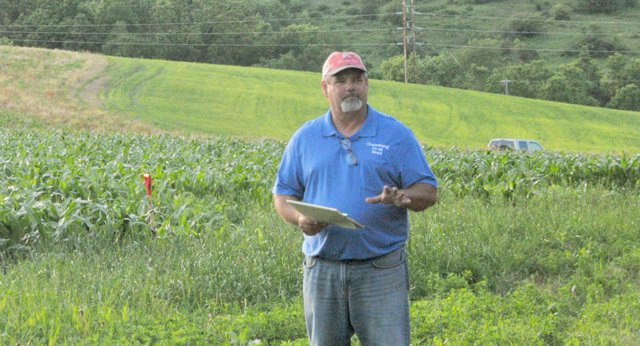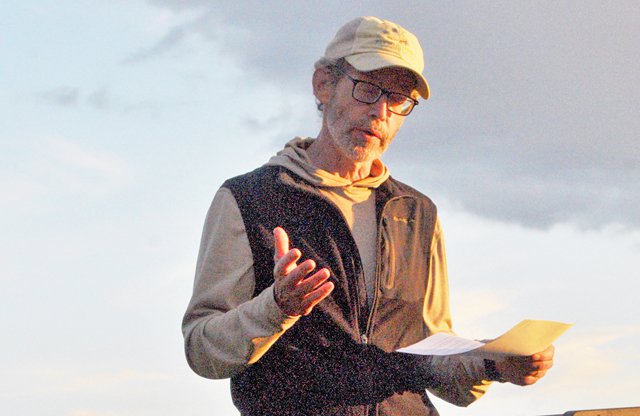CRAWFORD AND VERNON COUNTIES - About 30 farmers and supporters of the Tainter Creek Watershed Council gathered under dramatic skies for the first time in three months on Tuesday, June 23. The meeting took place outdoors in a field where Hornby Hollow farmer Brad Robson has been conducting field trials with cover crops, cash grain and grazing.


Robson farms the farm that his grandparents, Chester and Ida Robson, farmed and has worked to carry on the family’s longstanding conservation ethic.
“My dad was one of the first to convert his ground to no-till back in the 70s,” Robson said. “And we’ve always been big believers in strip cropping, and all the more so in the face of the increasingly large rainfalls we’ve seen in recent years.”
Robson is employed at the Chaseburg Co-op, and in recent years has expanded his work in animal nutrition to work more on the agronomy side of things. When his parents retired from farming about 20 years ago, Robson returned to the family farm and to farming.
In addition to growing cash grain crops, Robson also runs beef cattle. The experiments he is conducting in his fields are aimed at providing grazing for his cattle, improving soil health and weed suppression through cover crops, and ultimately at reducing costs and improving his farm operation’s profitability.
“My dad would always plant rye after corn silage or tobacco,” Robson said. “I’ve done a lot of studying and listened to some good speakers, and am taking an experimental approach on my acres to try to learn what works best for me, and to share my learnings with others.”
This year, Robson took one field on his farm and planted corn and four species of cover crops all at the same time, and in one pass with the same tractor. He applied no herbicides, and also experimented with widening his corn rows from 30-inch to 60-inch rows.
“What happens a lot with growing cover crops between corn planted in 30-inch rows is the covers get shaded out by the corn and don’t get enough light to put on good growth,” Robson said. “By widening my rows, I get better growth in my covers, which I am hoping will provide forage for my cattle once I harvest the corn.”
Robson said that one of his most important goals is to be able to graze his cattle for more months of the year, and to reduce his time and costs put into stored forage.
Robson planted a four-species cover crop that included annual rye, two species of clover, and a forage brassica. His hope is that the brassica will grow quickly, canopy out, and help to suppress weeds. He is experimenting with different cover mixes to learn what the cattle will eat and to maximize their nutrition.
“It’s an experiment, and we’ll just have to see how it goes,” Robson said. “Worst case scenario, if it doesn’t work, is I’ll just cut it with a haybine for baylage.”
Robson said that part of the experiment will be to calculate out the costs and benefits of the management approach. In this process, he will take into account the cost of planting the cash grain and cover crops, cost and potential reduced cost of fertilizer and herbicide inputs, cash grain yield and profit, and forage yield and reduced stored forage production costs.
New coordinator
At the meeting, Valley Stewardship Project’s (VSN) Matt Emslie reported that due to increased interest in forming producer-led watershed councils in other watersheds, he would be stepping back from his role in coordinating Tainter Creek Watershed Council (TCWC) activities. Emslie said there has been interest in forming watershed councils in the Hornby and Rush Creek watersheds.
“The Tainter Creek Watershed Council has become a role model for producer-led watershed councils throughout the state,” Emslie said. “Inspired by TCWC, other watersheds are looking to form and do similar work in their own watersheds, and so my role will be to assist them.”

Tainter Creek Watershed farmer Dani Heisler-Woodill will be transitioning into the role of TCWC coordinator at VSN. Woodill and her husband Ryan are part of the Woodhill Farms operation in the headwaters of Tainter Creek near Liberty Pole, and have been active TCWC members for several years.
Woodill will partner with Monique Hasseman, who works both for VSN and for the Vernon County Land Conservation Department (LCD) in a public-private funded position. Hasseman’s work with VSN is to assist with administering the Wallace Center Grazing Grant, and with mapping for landowners. At the LCD, Hasseman helps with education events, with watershed modeling for flood mitigation, and in facilitation of multi-agency partnerships aimed at flood mitigation.
Future education events
Woodill facilitated a discussion among the farmers present about how to be creative about education events in 2020, given the restrictions on gatherings due to the COVID-19 pandemic.
“It just doesn’t seem feasible or responsible to do the type of education events we’ve done in the last few years, with 300 participants gathered together in an indoor venue,” Woodill said. “However, we have other options including more field days like this one where we gather to view innovative management on member’s farms, or even for digital education events.”
Several farmers agreed to host field days on their farms, and the option of a major digital education event will also be explored.
“We need to be creative, and think outside the box,” Vernon County Conservationist Ben Wojahn said. “We still have 2019 funds from the DATCP grant, and we have $40,000 from our 2020 DATCP grant to spend.”
Woodill also reported that the group is in final stages of selecting a logo. Logo design options were created by a Viroqua High School student. Woodill reported that they will also be creating a web page for the council, and launching a presence on social media.

Surface water quality
David Krier, Water Quality and Citizen Science Coordinator for VSN, provided the farmers with a surface water quality report for the Tainter Creek Watershed. In 2019, VSN monitored 14 sites in the Tainter Creek Watershed, measuring for phosphorous, turbidity, and macroinvertebrates.
“Overall, the water quality monitoring results for the watershed are very good,” Krier said. “Levels of phosphorous, an indication of soil erosion, are well below the WDNR threshold, and in comparison to other nearby watersheds, are really excellent.”
Krier reported that in 2020, the number of monitoring locations in the watershed will be reduced to 11 sites, and will focus more on the headwaters reaches of the watershed.
“In addition to monitoring, we are also adding in consultations with various experts in the water quality monitoring field,” Krier said. “We will also begin measurement of conductivity, which is a good measurement of a waterbody’s ability to conduct electricity. What this measurement tells us is the extent of total dissolved solids in the water and its impact on potential dissolved oxygen levels.”
Krier reported that VSN has also obtained one year’s worth of measurements of nitrogen in the surface waters of the watershed. He emphasized that the data set is currently too small and of too short a duration to lead to any hard conclusions. Overall, based on a year’s worth of measurements, and review of some historical data, it appears that the trend may be for increasing levels of nitrogen.





